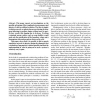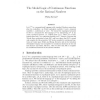12438 search results - page 44 / 2488 » The Magic of a Number System |
CEC
2003
IEEE
13 years 11 months ago
2003
IEEE
This paper reports on investigations on the possible advantage of the coupling between genomes and physics of cells in artificial evolution. The idea is simple: evolution can rely ...
AML
2010
13 years 8 months ago
2010
Let L be a propositional language with standard Boolean connectives plus two modalities: an S4-ish topological modality and a temporal modality , understood as `next'. We ext...
ICDCS
2009
IEEE
14 years 5 months ago
2009
IEEE
Retrieving sequential rich media content from modern commodity disks is a challenging task. As disk capacity increases, there is a need to increase the number of streams that are ...
GLVLSI
2009
IEEE
2009
IEEE
Physical unclonable function and true random number generator: a compact and scalable implementation
13 years 12 months ago
Physical Unclonable Functions (PUF) and True Random Number Generators (TRNG) are two very useful components in secure system design. PUFs can be used to extract chip-unique signat...
ALT
2007
Springer
14 years 5 months ago
2007
Springer
In this paper we consider learnability in some special numberings, such as Friedberg numberings, which contain all the recursively enumerable languages, but have simpler grammar e...


